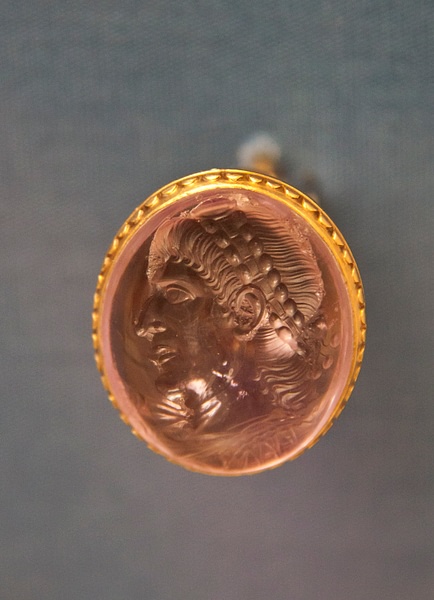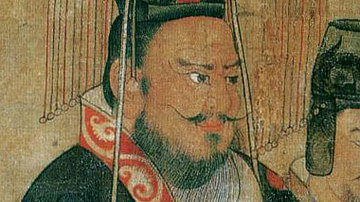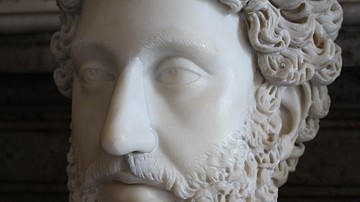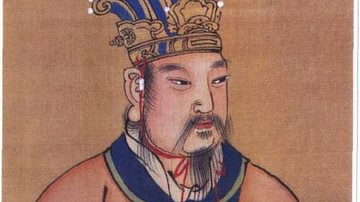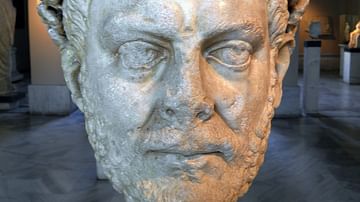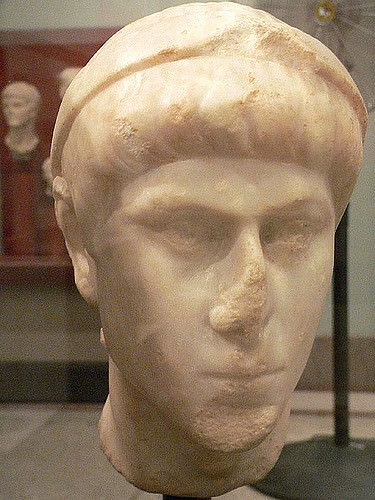
Constantius II ruled the Roman Empire between 337-361 CE. He was the second son of Constantine the Great and Fausta. Constantius was a devout follower of Arianism Christianity. Ruling for 24 years, he was the longest reigning son of Constantine and therefore, arguably, the most successful.
Early Life
Ammianus Marcellinus records his life and reign in great detail. However, the hostility of the historian has forever marred the reputation of this successful emperor, recording that his reign was plagued by imperial insecurity, court intrigue and an inability to solve widespread religious controversies.
Constantius was responsible for the slaughter of his cousins and uncles, of Theodora's line during the great massacre of 337 CE. Such a slaughter within the imperial family itself was unprecedented. Murdering his relatives (such as Dalmatius, Hannibalianus and Julius Constantius), whom he saw as challengers to his and his brothers' ascensions to the throne, Constantius secured his own position within the Empire. The only two male members of this line of the imperial family to survive were Gallus and Julian. Thus, after this slaughter and the division of the empire between Constantine's sons, Constantius was able to secure the most prestigious and wealthiest provinces in the east for himself, and perhaps more importantly; Constantinople – the new capital of the Roman Empire. Eventually, after the death of his brothers; Constantine II and Constans, he became sole ruler of the Roman Empire. However, learning the lessons from Diocletian and Constantine the Great he realised that to rule and secure the empire on his own was impossible, thus throughout his reign he subsequently promoted his only surviving male relatives, Gallus and later Julian as his Caesars.
Defending the Empire
The main criticism levelled at Constantius was his cautious and defensive foreign policy. This is understandable given that most Roman contemporaries, even in the Later Roman Empire, were still obsessed with the idea of conquest and expansion. Yet this defensive policy safeguarded the frontiers of the empire against the Sassanian Empire – which was resurgent during the reign of the ambitious and skilful Shapur II – and the increased threat of the Germanic tribes in the west. His policy was also extremely important in protecting and conserving Rome's limited manpower strength. The vicious cycle of usurpation, civil war and dynastic murder had led to wider imperial insecurity and vulnerability, making aggressive foreign campaigns ever more dangerous and unwise. The civil wars that had wrecked the empire were particularly damaging and always proved a huge drain on Roman manpower. For example, during Constantine's conflict with Magnentius, his brothers' murderer, Constantius lost 40% of his men while his rival's army suffered a loss of 2/3.
Therefore, although Constantius' foreign policy of defence and containment received a lot of criticism it proved a lot more effective than an aggressive policy would have done and indeed it actually formed the precedent for the later overall strategy of the Roman Empire.
Constantius was especially skilled at cementing the internal stability of the Empire – a fact that is often overlooked considering the bloody civil wars and unrest that had previously threatened the empire. During his reign, he faced many varied internal threats and challengers. These included;
1) Vetranio: who had briefly been proclaimed by the Danube legions, was quickly disposed of
2) Magnentius: survived three years of war with his brothers' killer. Finally defeated him at the battle of Mons Seleuci. (later proscribed the followers of Magnentius [Amm. Marc. 14.5.2-5])
3) Silvanus: the Frankish-born general was disposed of through a trick [Amm.Marc. 15.5.3-31]
4) Caesar Gallus: who was suspected of insubordination and was quickly checked and done away with.
5) Caesar Julian: openly rebelled against Constantius and succeeded – mainly because Constantius died before he could give battle.
It is important to note that Constantius II was the first ever Roman Emperor to publically and monumentally celebrate victory in a civil war [Amm.Marc. 21.16.14]. This was a completely new and unprecedented move by a Roman Emperor, especially when one considers that in the early empire Octavian changed his name to Augustus in order to actively distance himself from civil conflict. Constantius' decision to do this underlines the fact that the ability to protect against internal threats was now a major prerequisite of being a successful emperor during the Later Roman Empire.
Ammianus criticises Constantius throughout his narrative for his paranoia and his susceptibility to court intrigue and scheming courtiers. The historian states that this paranoia created a culture of suspicion and fear in Rome [Amm.Marc.21.16.8-9 & 21.6.1-3 & 8-10]. However, given all the schemes and plots against him his suspicions seem highly justified – indeed if more Roman Emperors had been so 'paranoid' perhaps fewer would have fell victim to palace coups and military rebellions.
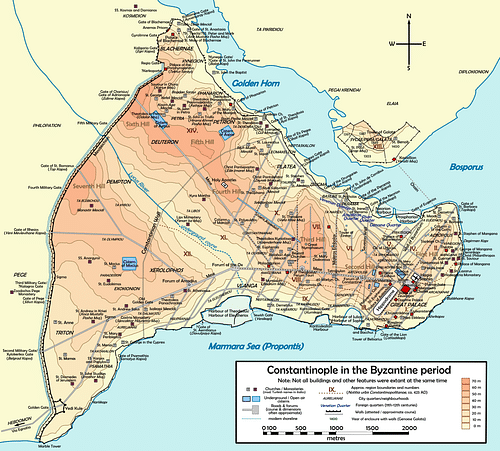
Constantinople & Religion
Given that Constantius was the longest living and most documented of the sons of Constantine it is in his reign that we can best see how the reforms introduced earlier by Constantine the Great developed and worked. This is especially true for the reign of Constantius as he did not change much himself but instead chose to continue with the administrative systems set in place by his father. For example, he ensured the distinction between military and civil posts.
During his reign, Constantinople increased in importance becoming more clearly recognisable as an equal to the Eternal City; Rome. Under Constantius the city increasingly became the centre of the Empire. He was the patron of many important building projects in the city; granaries, Horrea Constantia, bath houses and a library. In addition, the Church of the Holy Apostles was remodelled and improvements were made to the water supply.
Indeed after his work in the city the orator Themistius (Oration 3) stated that Constantinople was now no longer a second city but a true rival to Rome itself.
Constantius also furthered the religious policies of the Constantinian Dynasty. With the Edict of 365 CE he ordered the closure of all pagan temples, forbade access to them and prohibited the performance of sacrifice both private and public; stating that those who disobeyed were to be executed [Cod. Theod. 16.10.4]. Laws such as this and others were specifically designed to break the power and institution of temples in pagan religious practice. Temples were central to almost every activity in paganism, acting as sites of celebration of the cults. Therefore, Constantius' policies were evidently a direct attack on paganism. The Emperor also had the famous statue of Victory removed from the Senate house in Rome as he believed no Christian should have to work in the shadow of a pagan monument. However, other practices were allowed to remain such as the burning of incense and candles which would, interestingly, later be adopted by Christianity.
Constantius died of an illness in 361 CE while marching to do battle with his Caesar, Julian, who had rebelled and claimed the title of Augustus.
